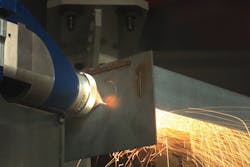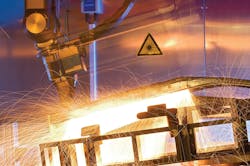Partners develop multifunctional laser tools for lightweight construction, e-mobility
AACHEN, GERMANY – Hybrid lightweight construction and electromobility (e-mobility) require a balancing act between flexibility and productivity. The Fraunhofer Institute for Laser Technology (Fraunhofer ILT), together with Bergmann & Steffen (Spenge, Germany), CAE Innovative Engineering (Beckum, Germany), and the Laser Processing and Consulting Centre (LBBZ; Geilenkirchen, Germany), is developing a multifunctional laser processing head and robot technology for flexible and economical production of sheet metal component assemblies.
A combination processing head (combi-head) from Laserfact (also in Aachen) will enable users to integrate cutting and welding, and also additively generate structures (FIGURE 1). The project partners are currently working on optimizing the combi-head in such a way that it can execute all three processes in a production plant “on the fly”—that is, without changing the optics or nozzles.
The project is also focused on developing intelligent design and simulation software for an optimized process chain. With the Digital Twins software, project partner CAE Innovative Engineering can image machines, processes, and components to be produced so that key figures of the process chains can be identified and improved.
Using the highly flexible the MultiPROmobil process chain, coordinated by Fraunhofer ILT and funded by the European Regional Development Fund (ERDF) and the State of North Rhine-Westphalia partners, can digitally display new vehicle components, and then test and evaluate the developed technology. In an industrial environment at project partner LBBZ, a robot that masters all three manufacturing disciplines will produce semibionic vehicle structures with a laser. As the first application example, the triangular control arm of an electric vehicle will be optimally designed and cut, then welded and reinforced with additive structures in the multifunctional laser robot cell, all without a single tool change (FIGURE 2). Of particular importance here is the flexibility of the clamping technology developed by Bergmann & Steffen.The project partners predict that engineering efficiency can be increased and startup times reduced by around 30% each. In addition, they want to reduce unit costs and resource consumption by at least 20% each.
The technology invented at Fraunhofer ILT with the combi-head from Laserfact is already being used in the industry—for example, when cutting and welding strip ends in coating and inspection lines of the steel industry, as well as when producing high-precision metal assemblies. With the further development of the combi-head, MultiPROmobil will now appeal, in particular, to small- and medium-sized companies that make an important contribution to the future market of e-mobility.
For more information, please visit ilt.fraunhofer.de.

